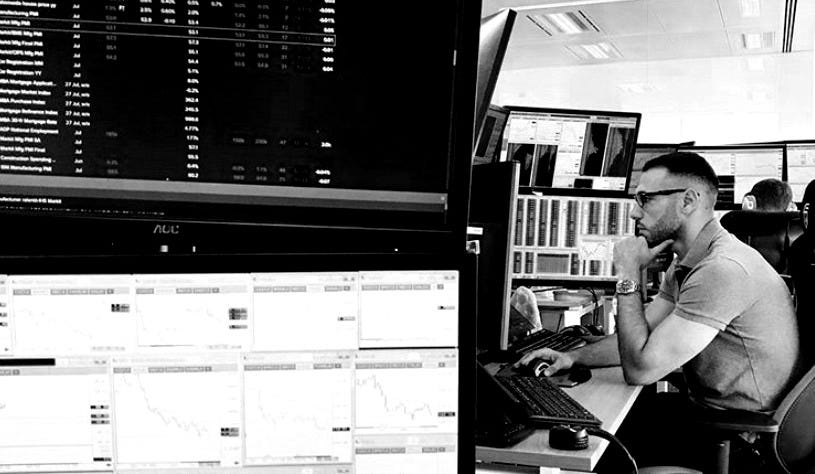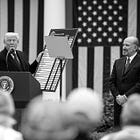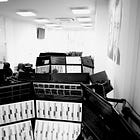A Trading Firm’s Q2 2025 Review: ’Tis But A Pullback. (Part I)
Fighting For Creative Stamina

Across the AXIA trading desks.
April-June 2025.
London, England, and Limassol, Cyprus.
The second quarter of 2025 was a trader’s market. The rapid narrative, with its conflict, plot twist, and resolution (volatility expansion and contraction), hasn’t been seen since that historical second quarter five years ago. If the first quarter of 2025 was a gradual accumulation of P&L over a concentrated flow coming in and out of the market, then this second quarter occurred within days. We recall Lenin said something similar.
AXIA’s performance this quarter has been explosive. More in Part II. There are parallels to Q2 2020, as Alex Haywood remarked. After Manic March 2020, Summer was a relative slumber, which many traders weren’t prepared for. Yet the floor is smarter now; it has adapted to the aggressive change in volatility and given back less than in 2020. This is high-quality market navigation: less concerned about daily details that younger traders should develop, but over time, established traders look further out to understand the “meta-cycle,” as Haywood put it. And how energy management to skill development adapts, not just the trading.
Imagine us together, watching the market flow and traders around early April, after ‘Liberation Day’. In the next three sessions, CME’s S&P June contract dropped over 15%. The Spot VIX hit over 50 in the same period. A week after Liberation, CBOE’s VIX April futures traded above 44s. (NB: There’s a difference between spot and futures VIX; the latter lags the former, often trading lower.) NYMEX’s WTI Crude Oil May contract traded roughly $9 a barrel lower, a drop of over 13%.
After the 90-day tariff pause—Be Cool!—on April 9th, numerous false dawns followed. Countries exchanged tit-for-tat measures, leading to frustrating and drawn-out comment and headline trading, extending into late April and May with a sense of weekly déjà vu. During central bank meetings in May-June, trading opportunities were limited. Yet, Fed speak tilted dovish, providing one of the best trades via the Fed’s usually hawkish Bowman. This culminated in Chair Powell’s ‘revelation’ on July 1st that the FOMC would have cut rates if not for tariffs1
Why not revisit the Dispatches of Liberation Day itself? Seen through the eyes of this fast-growing, young, seven-figure news trading specialist.
Then! You were suddenly trading headlines of airstrikes on Iranian nuclear facilities in mid-late June. After this, the S&P hit an all-time high before the quarter ended, and the spot VIX traded around 20s a month prior. Would you have believed me in April if I told you where we’d be in less than ninety days, knowing just the upcoming headlines?
Anticipation is worse than reality. Six years ago, many feared the path to rate normalisation and hikes back to a ‘sensible’ and positive number—depending on where you were—heralded the end times. Then came the pandemic.
The markets of the 2020s differ from the 2010s. Tolerance has improved, with a built-in veteran presence and experienced participants, compared to the supposedly meek and fragile pre-pandemic markets under ZIRP and QE-max. The belief in endless liquidity and the implicit and explicit central bank put is so ingrained that it follows one mantra: if you don’t like what you see, discount harder; discount faster. Why be resurrected as the bond market, as James Carville quipped, to be feared by all, when one can be loved as the great Spoos?
The Q2 2025 story is: what story? After the large and rapid moves of early April, the VIX reportedly experienced the fastest-ever reversal (volatility contraction) since 1990. 2It took roughly three weeks to trade from 40 to 20. Market stabilisation began with the 90-day tariff pause on April 9th. This was faster and snappier than the Tariff 1.0 theme in Trump’s first term. As noted in All The World’s A Stage, this is reflected in the containment of volatility within the energy complex following the U.S.-Israel-Iran airstrikes, then the potential war theme, and a muted response in various asset classes, especially fixed income. Notably, the lack of a Bund bid on 13 June, trading even lower during the geopolitical flashpoint.
If you’d been in for most weeks of April and May, and parts of June, you wouldn’t know anything was going on if you went commando: looking at no charts, news feeds, or talking to anyone but observing the current order flow.
Q2 is characterised by underreaction because all the action occurs in a few days, or a single day, preferring instant amputation over enduring brutal treatment to save an arm or leg. The intensity has ramped up; time has accelerated. This relationship between volatility and time led to important observations for market navigators for Q3 2025.
The High Level: Observations For Your Q3
1. Preserving and expanding ‘Creative Bandwidth.’
Fatigue management of the body and mind with its creative faculties was tested. Though they are the same as in Trading With Your Body. How to manage and resuscitate both when stuck in a perpetual déjà vu of April-May? Many headlines were duds, risking to give back early April gains. This is the effect of moving from Phase 2 to 3 within an established theme—keeping gains becomes more important than making them—as The Warrior observed in Traders of Our Time.
Haywood and a senior trader discussed fatigue and imagination. The trader felt increasingly myopic compared to a strong Q1. His imagination for future world states has diminished, as he fights a “reduction in our ability to come up with more plans,” as Haywood described it. Once the market cycle matures, the theme becomes well-known. More nuance and skills are required to trade and monetise this period successfully. He continued this discussion about understanding foundational health and managing energy levels to adapt to volatility. To replenish during lower volatility, allowing resilience for sleepless nights during action. A military dictum: always sleep when you can, because the next chance is unpredictable.
“What’s your game plan for fatigue?” Haywood continued. “To stay healthy and mentally sharp with quick processes ... like a three-minute cold plunge instead of a forty-five-minute gym session ... to flush the blood; then activate the brain to imagine and plan. January was great for [this senior trader] because he was rested in December. So, how do you manage fatigue and its influence on imagination?”
This quarter, the emphasis on imagination for senior traders is due to AXIA’s collaboration with story-scientist Angus Fletcher and his upcoming book, Primal Intelligence. These innate intelligences—intuition, imagination, common sense, and emotion—are vital for the human market navigator; success depends on their deployment. Specific emotions arise when a navigator fails to use imagination or intuition. Readers of Asymmetrist’s newest entry to the ‘Idea Index’—The Markets Can Only Be Navigated, Not Solved—would understand the link to ‘VUCA’: “volatility, uncertainty, complexity, ambiguity.” Practitioners would agree with this description of markets, as it’s a concept the U.S. Military uses to describe our complex world. It’s relevant, as Fletcher has been working with U.S. Special Forces to understand how these four intelligences help navigate our world. A world that is less inaccurately described as complex and non-linear—like a rainforest—rather than complicated and linear, like a bicycle.
When one does the same thing repeatedly (trading or otherwise) and gets a favourable response—it works!—this self-reinforcing cycle reduces imagination in anticipating future world states, especially when they render the useful to useless, often resulting in inaction. When fatigued, we notice we rely on what we reflexively know—actions, words or both—rather than entertaining novelty. This leads to narrow focus, making it difficult to break away or think and act differently.
This mental pivot was critical for a hidden rates trade at the end of June, covered in All the World’s A Stage. It required more imagination and creative bandwidth. The trade was ‘hidden’ because mainstream attention was on the Iran-U.S. nuclear facility airstrikes and retaliation. Yet, an opportunity arose from Fed’s Bowman, where several traders excelled in relevant markets, particularly in the short end: STIRs, the U.S. 2-year, and 5-year notes.
Haywood observed that the U.S.-Iran-Israel strike and escalation theme was an excellent microcosm—a sped-up example of how the market digests, prices, and flows around a theme. As The Warrior said, Phase 1-2 can be fast, direct, and shocking; or slow-burners, as not enough participants have caught on to the implications. Phase 2-3 reaches ‘peak theme’, allowing for the biggest performances and destructive days. Both cluster around the same period, as the market transitions from clear rapid moves to aggressive reversals. Therefore, newer traders shouldn’t just review past examples, but intensely record this period because they have just traded and lived through it.
The trading floor’s “extended mind” helps with this creative bandwidth, as in Traders of Our Time, leveraging Annie Murphy Paul’s work. More eyes and attention are spread over more places. Critically, these eyes and minds (creative faculties) are from specialists who understand this rates trade opportunity. This is a significant advantage, especially when fighting fatigue. This late June period was a fight for creative stamina.
2. Work To Expand Your Opportunity Set
In a recent April conversation with The Hero, he remarked on the dangers of the market providing recurrent and similar opportunities to traders since the new year, particularly in trading news and headlines. This has been more so since May and June. The risk is that the trader, the floors, and the firm begin to optimise—‘solve’—that market state, embedding fragility in their career once dramatic change occurs. The longer this continues, the worse it can become due to feedback loops. Newer, younger traders risk becoming dependent on a narrow skill set. In comparison, older traders with a broader skill set forgo the needed reps and immersion, or deliberate work to prepare for a market state without news-trading opportunities, momentum, or volatility.
The Hero from Traders of Our Time is an excellent example of a ‘strategic’ trader rather than a ‘tactical’ one. These terms are reductive but necessary. We defined the former as one who creates opportunities through engaging a lattice of disparate skills and a unique framework to identify opportunities. The latter, the tactical trader, can only exploit market offerings; thus, they must be a far greater trader than necessary to monetise obvious opportunities.
The Q1 and Q2 opportunities have been so frequent that few strategic traders are emerging or advancing. As noted in ‘Defeating the Discombobulating Dialectic, Part II’:
These are situations where the market seemingly reacts to the insignificant or is unmoved by what we deem as critical news. Will it go or not? To a ‘technical trader’ these are lone volatility injections that trigger trades. Market selection, sizing, and management are handled by their overt framework. Yet, this is inaccessible to a pure news-event-fundamental-macro (assign your box) trader, whose market selection, sizing, and management is left to the devil in the details: the headline—and this little devil is the most wily and unreliable of all.
What happens when the volatility dies down and no material changes occur in the ‘real’ and financial world? Is this unbelievable? Note the emerging proclamations from social media that this higher volatility is the new normal. We know how the “this time is different” story ends. A no-story, low volatility environment in the real and market world would be the most shocking, yet not surprising. We’ve seen how fast volatility crunches after expansion. Would those who traded during the news-heavy days of 2007-13 expect a complete suppression of volatility and a dry ‘period’, of static market and a ‘stable’ world for six to seven years? We know they didn’t, as The Collector in Traders of Our Time observed and warned. Many waited “for the markets to become good again.” Then the career culling started—some trading floors, 150-strong, to less than fifty in the blink of an eye. Does anyone quit after their best-ever years? A few have similarly remarked.
A trader’s narrow skill set is reflected in waiting for the markets to “become good again.” The Collector became obsessed with widening it, observing the dangers, echoed by The Hero, of becoming too dependent on ‘dramatic’ opportunities. The well-honed skillset—optimised, ‘solved’ the ‘07-‘13 environment—became brutally narrow to capture the new skills, metagame, and thinking of the late 2010s. Thus was born The Engineer, from Traders of Our Time, now an eight-figure market profile-as-framework strategic trader. Another dictum: in low volatility, prepare for high volatility. In high volatility, prepare for low volatility. War and peace, history says, have a similar relationship.
Many trading careers—whether boosted or begun—happen between regime changes, not within the current regime. Readers have observed this in the ‘real world’ too. The Engineer was flat on his account in the first years of his career, during the worst low-volatility regime. However, one day the Bund cracked, followed by the EuroStoxx, and a $30,000 up-month emerged, launching his career.
A few years later, his career took off, nearing Trump 1.0, then the pandemic and dynamic markets. He had a broad skill set, positivity, and momentum, marked by increasing trading size and ambition after long incubation. Roaring to go from pole position, not scrambling to catch up or waiting for better markets. Another instance of how repeated action and reward diminish imagination under fatigue. Over the fatigue and nerve-wracking long periods of unstoppable drawdown from a regime shift, this self-reinforcing vortex of resorting to what worked previously is reinforced. Tunnel vision is comfort vision.
Immediate action suggestions:
Are you prepared for an extended low-volatility regime? Assume it will last until Christmas or longer. Remember: “it will be over by Christmas” is a dangerous assumption, as the 20th century found out.
Be ready to jump back into trading news and volatility, using creative bandwidth if needed. Perhaps we enter a period where every quarter is a trader’s market, with fluid markets, shocks, instability, or constant real-world changes creating opportunities. Are you ensuring you don’t reinforce or over-optimise for today, sacrificing future preparation?
Can you identify opportunities through a unique framework to spot rare ones unaffected by market volatility, momentum, or headlines?
The trader is always made in the next cycle. If you scramble to adapt in a new environment, you’ll likely scale what you’ve learned towards the end. Use the quiet times this year to widen your skill set. Explore your adjacent possible: you understand the auction and order flow on the price ladder, can you extend this to the market profile? Can you identify opportunities to deploy breakout flow trading? Remember Bobby Fischer’s eternal quote: “Tactics flow from a superior position.” The Collector noticed The Hero and The Engineer treated a “market profile play” with the same seriousness and preparation for over a week as news traders for a central bank meeting. To them, that was a bigger opportunity because few would notice.
In 2019 and 2020, London floor news-traders chatted, bantered, and walked around during ‘quiet markets’. The only traders with their heads down were the strategic Hero and Engineer, while the chatty news-traders, with little to do, remarked: “Why’s the Bund gone up so much?” Guess who was long with a thousand Bund lots since 7 a.m.?
Your adjacent possible is developed by accumulating “spare parts” from other traders, especially domain experts. Inch towards them. Who is better in a low-volatility, static market? Whose view or framework connects to yours? Accumulate what they know, connect the dots, and make it your own. Imagine you are them, ask what they would think, say or do, as Angus Fletcher remarked in a recent ‘Primal Intelligence’ workshop. Use their story wisely.
Here’s To Your Q3. Good Trading To You All.
»Part II Has Been Published!»
Catch Up With This Quarter’s Trading Floor Stories!
Parts II-IV are linked within Part I.
Read Much More About These Special Traders!
Much more to be found in
Traders of Our Time: Navigating the Market’s Impossible Landscape.
10 Elite Traders.
125 Years of Mastery.
500 Pages of
Lessons, Practices
and Original Stories
For You To Become the Trader
You Always Wanted To Be.
Quoted during Fed’s Powell speech at ECB’s Sintra, quoted by CNBC.
According to Bespoke Investment Management, quoted via Colin Laidley (Investopedia).





